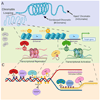Invited Review: Epigenetics in neurodevelopment
- PMID: 32056273
- PMCID: PMC7174139
- DOI: 10.1111/nan.12608
Invited Review: Epigenetics in neurodevelopment
Abstract
Neural development requires the orchestration of dynamic changes in gene expression to regulate cell fate decisions. This regulation is heavily influenced by epigenetics, heritable changes in gene expression not directly explained by genomic information alone. An understanding of the complexity of epigenetic regulation is rapidly emerging through the development of novel technologies that can assay various features of epigenetics and gene regulation. Here, we provide a broad overview of several commonly investigated modes of epigenetic regulation, including DNA methylation, histone modifications, noncoding RNAs, as well as epitranscriptomics that describe modifications of RNA, in neurodevelopment and diseases. Rather than functioning in isolation, it is being increasingly appreciated that these various modes of gene regulation are dynamically interactive and coordinate the complex nature of neurodevelopment along multiple axes. Future work investigating these interactions will likely utilize 'multi-omic' strategies that assay cell fate dynamics in a high-dimensional and high-throughput fashion. Novel human neurodevelopmental models including iPSC and cerebral organoid systems may provide further insight into human-specific features of neurodevelopment and diseases.
Keywords: DNA methylation; chromatin remodelling; developmental disorder; epitranscriptomics; neurogenesis.
© 2020 British Neuropathological Society.
Conflict of interest statement
Figures


References
-
- Hansen DV, Lui JH, Parker PRL, Kriegstein AR. Neurogenic radial glia in the outer subventricular zone of human neocortex. Nature. 2010. March;464(7288):554–61. - PubMed
Publication types
MeSH terms
Grants and funding
LinkOut - more resources
Full Text Sources

